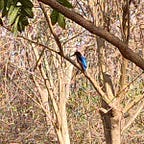Breath is my muse.
In my previous blog post An experience of Nature’s alchemy, I had mentioned experiencing fleeting moments of tranquility with the regular practice of Aṣṭāṅga vinyāsa. Witnessing each moment while staying anchored to my breath in daily practice provided an experience of lightness from the usual burden of thoughts, as if a reset button was pressed within me. We often relate our existence with the thinking aspect of the mind, like the famous expression from Rene Descartes “I think, therefore am !”. However as my body moved through the sequence of postures I wasn’t thinking, on the contrary found myself listening.
Ancient wisdom from Śrīmadbhagavadgītā recommends to be “actively calm and calmly active”. Seeing action in inaction and action in inaction makes one wise, stated in chapter 4 verse 18 as:
“karmaṇyakarma yaḥ paśhyed akarmaṇi cha karma yaḥ
sa buddhimān manuṣhyeṣhu sa yuktaḥ kṛitsna-karma-kṛit” ||1||
(karmaṇi — action; akarma — in inaction; yaḥ — who; paśhyet — see; akarmaṇi — inaction; cha — also; karma — action; yaḥ — who; saḥ — they; buddhi-mān — wise; manuṣhyeṣhu — amongst humans; saḥ — they; yuktaḥ — yogis; kṛitsna-karma-kṛit — performers all kinds of actions)
Nearly three months after the daily practice of Aṣṭāṅga vinyāsa, I experienced a glimpse of this intelligence dawning upon me. I believe this was my “atha yoga-anuśāsanam” moment. The first aphorism from Yogasūtras, a collection of sūtras(aphorisms) on theory and practice of Yog written by sage Patañjali in the early centuries in India.
“Atha yoga-anuśāsanam” ||2||(Atha: now, anuśāsanam: discipline)
Meaning discipline of Yog starts now, is the very first aphorism from the samādhi-pāda chapter of Yogasūtras. This aphorism lays emphasis to be always present in the moment.
As I reminisced about the inertness of the mind (inaction) during the practice of yogāsanas (action), I realised that the breath played a crucial role to it. Listening to the sound of breath during the practice felt as if I’m standing next to an ocean, watching waves rise and merge back into the same. Observing the continual rhythm of the breath within me, I continued to learn the primary series of Aṣṭāṅga vinyāsa. I would later learn that the breathing is an act of sacrifice to higher intelligence/order.
Aṣṭāṅga Yog (Ashta: eight, anga: limbs) is the pathway recommended in ancient Indian scriptures towards salvation. Let’s briefly go through the eight limbs here:
- Yama: ethical norms towards society.
- Niyama: body-mind cleanliness practices for self discipline.
- Āsana: posture, for the lack of a better word are āsanas often translated as postures in western literature but we will shortly discover why that isn’t the appropriate interpretation.
- Prāṇāyāma: breath regulation with bandhās (energy locks) in specified parts of body.
- Pratyāhāra: drawing the awareness of the sense organs inwards.
- Dhāraṇā: one-pointed concentration/focus.
- Dhyāna: staying in dhāraṇā, meditation
- Samādhi: staying in union with higher/cosmic consciousness.
I will be touching upon the āsana limb of Aṣṭāṅga Yog, Aṣṭāṅga vinyāsa here. In Yogasūtras asanas are defined as:
“Sthirasukhamāsanam” ||3||(sthiram: steady, stable, sukham: comfortable)
Meaning being steady, stable and comfortable in a posture is called āsana. When asanas are practiced consistently over a period of time, they prepare one to sit in meditation blissfully undisturbed by outside or bodily sensations. In the practice of Aṣṭāṅga vinyāsa one moves in a three dimensional space of sthitis (positions where postures are held for a couple of breaths), dṛṣṭis (gazing points) and swasā (breath),together known as Tristhānā, tri: three, sthānā: places). And moving from one sthiti to another with coordinated breaths is called vinyāsa.
Aṣṭāṅga vinyāsa primary series (Yog-chikitsa: yoga therapy) currently practised, roughly comprises of about 60 postures. This sequence is believed to be highly therapeutic in nature and brings balance between the two halves of the body rendering good health in time. We start with sun salutations to amply warm up the body so as to carry out an injury free practice. Then proceed to the limbs with a series of standing postures, followed by seated/supine postures focusing on the abdomen and then gradually enter into an inversion sequence to strengthen the spine and cool down the body. The practice is then completed with a closing sequence of Padmāsana postures, where slow mindful breathing is practised as a gateway to the limb of prāṇāyāma. The sequence effectively helps us take our awareness inwards from the periphery of the body.
Depending upon the posture dṛṣṭis are focused at specified parts of body or outside. The breathing method adopted during the practice, is done with smooth hissing sound with emphasis at the back of the throat. This kind of breathing practice essentially creates little heat which helps improve blood circulation and aid progressive purification in the body. As the practitioner moves through the sequence of postures, he/she is advised to maintain awareness on the sound of breathing in order to draw one’s attention away from the external world. The mindful practice of Aṣṭāṅga vinyāsa through introspection of the sense organs prepares one to ascend the higher limbs of Aṣṭāṅga Yog.
“So’ham”
The part 2 of the this article can be found here .
“Sri Kṛṣṇārpanamastu”.
